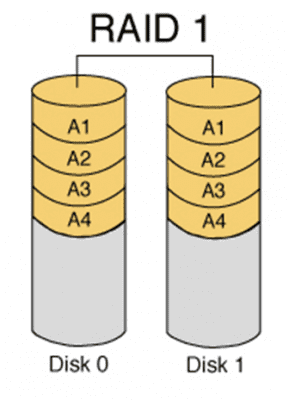An Overview of RAID Storage Levels
This RAID levels comparison article provides an overview of RAID storage levels. Enterprise demands for increased storage capabilities, improved performance, and disaster recovery, have all driven the need for alternative storage solutions. And though failures may be more rare than in previous years, for many organizations, the cost of even an hour of downtime is significant enough to warrant the added protection afforded by what is known as a drive array.
This array is a collection of two or more drives that combined, provide a single point of data storage. For the operating systems as well as network users, the array appears as a single drive. This technique is alternately referred to as either Redundant Array of Inexpensive Disks or Redundant Array of Independent Disks, abbreviated RAID. There are several RAID implementations, known as levels, but only a few are widely used.
RAID 0
RAID 0, also called striping, is a scheme where data is divided into blocks and distributed across the drives in the array. This level does not provide redundancy, so consequently it has the best overall performance. For this reason, it is not suitable for mission critical situations, but is best used in situations where improved performance is the primary driver.
RAID 1
There are two implementations of RAID 1: mirroring and duplexing. With both schemes, data is duplicated on a second disk. Mirroring uses a single drive controller, while duplexing uses two controllers. In the event of a single drive failure, data can be read or written from the other drive, providing fault tolerance. And in the case of duplexing, even a controller failure won’t bring down the system. However, there won’t be any performance improvements, but instead, a potential decrease in write performance.
RAID 5
RAID 5 is called striping with distributed parity. Data and parity or error detection and correction code, is striped across three or more drives. Parity is stored on a dedicated drive, which results in less available storage space. If a drive fails, data can be recovered from the remaining data blocks and the parity information. This level also features improved read and write performance because data can be read or written simultaneously across multiple drives.
RAID 0+1 (01)
This is the first of the hybrids, which simply combines other RAID levels. RAID 0+1 (also called 01) mirrors and stripes data simultaneously. Combining striping and mirror marries high performance with fault tolerance, making this one of the most popular levels. Under this scheme, two striped arrays are created, and one acts as the mirror to the other. This requires a minimum of four drives.
RAID 1+0 (10)
With this RAID level, data is mirrored and striped simultaneously. Most often, this is implemented with four drives, and one mirrored drive set is striped. This provides even higher fault tolerance and performance. RAID 10 differs from 01 in that things are reversed. Where 01 is a mirror of stripes, 10 is a stripe of mirrors.
RAID 5+0 (50)
The last hybrid model involves striping across multiple RAID 5 arrays. So, even if one drive from each array fails, operations could continue. This requires a minimum of six drives, and provides improved write performance than RAID 5 alone. Because of the number of drives, this implementation is expensive but useful when fault tolerance and performance are critical.
Summary
The intent of the RAID array is not to prevent failure, but to reduce or eliminate downtime. Factors such as cost, application requirements, and performance will determine the RAID level that is most appropriate for your enterprise. And of course, as only the most popular implementations have been discussed here in this comparison of RAID levels, there are additional levels that you may want to consider.
Related article:









